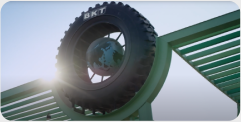How to evaluate the purchase of a new loader? Fuel, maintenance, tire replacement and repairs: let's analyze these factors one by one.
Dear readers, today we are coming back to the theme of quarries, mines and constructions. In particular, we’d like to give you some tips for correctly evaluating the purchase of a new loader.
Buying a new piece of equipment is never a decision to be taken lightly. Choosing the right loader isn’t a matter of luck, and its initial cost isn’t the only parameter you should consider.

Just think that, according to a recent survey of a leading manufacturer, in which the IT data of thousands of pieces of quarry and construction machinery and vehicles operating worldwide were analyzed, the initial price of a loader amounts to only 25% of the total cost it entails throughout its entire life cycle.
So, what about the remaining 75%? Here is the breakdown of costs:
- Fuel 56%
- Maintenance 18%
- Tire replacement 15%
- Repairs 11%
Well, how to evaluate the purchase of a new loader then? Let’s consider the main factors one by one.
Dimensions
It is important to choose a loader by the right size, according to the type of operations, the application, and the specific conditions at your site. If we are talking about large quarries or open cast mines, the vehicles will need to have great dimensions in order to face long routes under harsh conditions, whereas in smaller caves they will have to be smaller, proportionally to the works that need to be done.
What to evaluate, exactly? First of all, the volume of rock or mined material; then, other aspects will have to be considered, such as the load capacity of the other vehicles present on site. It would be pointless to buy an oversized loader, as compared to the mining capacity of the deposit, or a loader that can load more tons of material than the actual capacity of the dumper that will then carry it. There has to be some balance!
Duration
For how many hours will the vehicle be able to work during its operating life? This is certainly one of the important factors to consider at the moment of purchase - the ratio between the initial cost and the expected working hours gives you a better idea of the cost distribution over the years of use.
Experts think that a loader has an average life cycle of about 30,000 operating hours, ideally 2,000 per year. These data, along with those declared by the manufacturer, can offer you useful evaluation elements.
Maintenance, tires and repairs
Ordinary maintenance costs certainly have to be considered for a clear evaluation of the Total Cost of Ownership TCO (i.e. the total amount of all costs in relation to the entire operating life). Periodically, the vehicle needs to be inspected in order to assess whether some components should be replaced (oil and air filters, oil, hydraulic cylinders, etc.) and, after a certain amount of operating hours, tire replacement needs to be scheduled, too.
Tires for this type of equipment are very expensive, and considerably impinge on the company’s budget. This is why you should choose them carefully: they must be strong, offer high performance, last over time and resist to punctures and damages due to external agents. Quarries have an extremely rough terrain: rocks, rubble, uneven roads, continuous ups and downs along the routes, as well as mud when the weather is rainy, are conditions that put the tires to the test.
From this point of view, with BKT’s Earthmax line you have it all. In fact, it has been specifically conceived for dumpers, wheel loaders, dozers and graders employed in quarries, mines and wherever the working conditions are particularly tough.
Finally, let us not forget possible glitches, like minor breakdowns or accidents that require unplanned interventions, with consequent costs for the repair or the spare parts, or those due to the machine downtime, implying a loss of productivity and profit for the company.
Fuel
Following the recent laws on engines emissions, manufacturers have completely renewed their loader lines. This certainly is an aspect you should consider, when choosing your new wheel loader.
Nowadays, fuel economy is constantly improving and, thanks to this innovation, lots of manufacturers have taken the opportunity to add new features.
This is a great step forward, which allows selecting eco-friendly engines over their entire life cycle. This way you can preserve the environment, but also your productivity by optimizing the operating costs.
Has this been useful? Now you will have all the elements to choose the perfect quarry loader for your specific needs!





